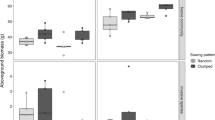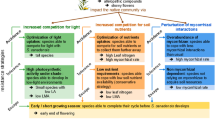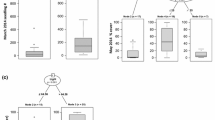Abstract
Competition exerted by native plant communities is an important component of biotic resistance against the spread and impact of non-indigenous plant species in novel habitats. However, how the role of biotic resistance varies along environmental gradients to delay invasions is less clear. We conducted two field experiments to determine how competition from native communities affects colonization of a recognized invader of grasslands, Hieracium pilosella L., in the Fuegian steppe along different environmental gradients at regional and landscape scale. We assessed the role of competition on invader survival and growth along a climate gradient at regional scale (4.7–6.6 °C and 270–450 mm year−1), and across four major plant communities (i.e. meadows, grasslands, scrublands, and heathlands) along a topographic catena. At regional scale, the climate gradient showed a 33% reduction in H. pilosella survival at the coldest and wettest extreme, while reduced its biomass in 41% at the warmest and driest site, in the opposite extreme of the gradient. Competition caused a 34% decrease of the invader biomass, similarly along the climate gradient. At landscape scale, the topographic gradient had a stronger effect on invader survival reaching a 67% reduction in lowland meadows due to flooding events, while competition reduced in 29–39% the invader biomass only in grasslands or scrublands with negligible effects on low-resource heathlands. These results suggest that biotic resistance plays a significant and similar role along the climate gradient to delay invasion at regional scale, but at landscape scale is only determinant for rich-resource communities in absence of abiotic stresses.



Similar content being viewed by others
Data availability
In case of acceptance, we will deposit our data in a public repository, such as the institutional public repository from CONICET (ri.conicet.gov.ar) or Dryad Digital Repository.
References
Allan HH (1924) Notes of the occurrence of certain exotic plants in New Zealand. N Z J Agric 29:311–315
Anchorena J, Cingolani A, Livraghi E, Collantes MB, Stofella S (2001) Manejo del pastoreo de ovejas en Tierra del Fuego. Edipubli S.A., Buenos Aires
Asner GP, Vitousek PM (2005) Remote analysis of biological invasion and biogeochemical change. PNAS 102:4383–4386. https://doi.org/10.1073/pnas.0500823102
Bates D, Maechler M, Bolker B, Walker S (2015) Fitting linear mixed-effects models using lme4. J Stat Softw 67:1–48
Bishop GF, Davy AJ (1994) Hieracium pilosella L. (Pilosella officinarum F. Schultz & Schultz-Bip.). J Ecol 82:195–210. https://doi.org/10.2307/2261400
Braun K, Collantes MB, Oliva G, Goñi L, Humano G, Mirol P, Pignataro G, Simón P, Wulff A, Dettori S (2009) Relevamiento y monitoreo de las especies nativas y exóticas del género Hieracium en el Sur y Sudoeste de Santa Cruz. Informe Técnico CFI, pp. 37
Broadbent A, Stevens CJ, Peltzer DA, Ostle NJ, Orwin KH (2018) Belowground competition drives invasive plant impact on native species regardless of nitrogen availability. Oecologia 186:577–587. https://doi.org/10.1007/s00442-017-4039-5
Buckley YM (2008) The role of research for integrated management of invasive species, invaded landscapes and communities. J Ecol 45:397–402. https://doi.org/10.1111/j.1365-2664.2008.01471.x
Byun C, de Blois S, Brisson J (2013) Plant functional group identity and diversity determine biotic resistance to invasion by an exotic grass. J Ecol 101:128–139. https://doi.org/10.1111/1365-2745.12016
Byun C, de Blois S, Brisson J (2015) Interactions between abiotic constraint, propagule pressure, and biotic resistance regulate plant invasion. Oecologia 178:285–296. https://doi.org/10.1007/s00442-014-3188-z
Byun C, de Blois S, Brisson J (2018) Management of invasive plants through ecological resistance. Biol Invasions 20:13–27. https://doi.org/10.1007/s10530-017-1529-7
Casper BB, Castelli JP (2007) Evaluating plant-soil feedback together with competition in a serpentine grassland. Ecol Lett 10:394–400. https://doi.org/10.1111/j.1461-0248.2007.01030.x
Cipriotti PA, Rauber RB, Collantes MB, Braun K, Escartín C (2010) Hieracium pilosella invasion in the Tierra del Fuego steppe, Southern Patagonia. Biol Invasions 12:2523–2535. https://doi.org/10.1007/s10530-009-9661-7
Cipriotti PA, Bigazoli F, Batista WB, Collantes MB (2019) Multiple pattern analysis reveals insights about drives of hawkweed invasion into the Fueguian steppe at different scales. Biol Invasions 21:2385–2399. https://doi.org/10.1007/s10530-019-01986-y
Collantes MB, Anchorena JA, Koremblit G (1989) A soil nutrient gradient in Magellanic Empetrum Heathlands. Plant Ecol 80:183–193. https://doi.org/10.1007/BF00048041
Collantes MB, Anchorena J, Cingolani AM (1999) The steppes of Tierra del Fuego: floristic and growth form patterns controlled by soil fertility and moisture. Plant Ecol 140:61–75. https://doi.org/10.1023/A:1009727629777
Collantes MB, Escartin C, Braun K, Cingolani AM, Anchorena J (2013) Grazing and grazing exclusion along a resource gradient in Magellanic meadows of Tierra del Fuego. Rangel Ecol Manag 66:688–699. https://doi.org/10.2111/REM-D-11-00201.1
Conti L, Block S, Parepa M, Münkemüller T, Thuiller W, Acosta ATR, van Kleunen M, Dullinger S, Essl F, Dullinger I, Moser D, Klonner G, Bossdorf O, Carboni M (2018) Functional trait differences and trait plasticity mediate biotic resistance to potential plant invaders. J Ecol 106:1607–1620. https://doi.org/10.1111/1365-2745.12928
Corbin JD, D’Antonio CM (2004) Effects of exotic species on soil nitrogen cycling: implications for restoration. Weed Technol 18:1464–1467. https://doi.org/10.1614/0890-037X(2004)018[1464:EOESOS]2.0.CO;2
Covacevich N, Uribe I, Lira, R (1995) Prospección de pilosella (Hieracium pilosella L.) en terrenos de uso ganadero de la XII Región. Informe. INIA/CRI Kampenaike. SEREMI de Agricultura, Intendencia XII Región, Punta Arenas, Chile, p 19
Davis MA, Grime JP, Thompson K (2000) Fluctuating resources in plant communities: a general theory of invasibility. J Ecol 88:528–534. https://doi.org/10.1046/j.1365-2745.2000.00473.x
Davis MA, Thompson K, Grime JP (2005) Invasibility: the local mechanisms driving community assembly and species diversity. Ecography 28:696–704. https://doi.org/10.1111/j.2005.0906-7590.04205.x
Day N, Buckley HL (2011) Invasion patterns across multiple scales by Hieracium species over 25 years in tussock grasslands of New Zealand’s South Island. Aust Ecol 36:559–570. https://doi.org/10.1111/j.1442-9993.2010.02191.x
Díaz S, Fargione J, Chapin FS, Tilman D (2006) Biodiversity loss threatens human well-being. PLOS Biol 4:1300–1305. https://doi.org/10.1371/journal.pbio.0040277
Eskelinen A, Harrison S (2014) Exotic plant invasions under enhanced rainfall are constrained by soil nutrients and competition. Ecol 95:682–692. https://doi.org/10.1890/13-0288.1
Firn J, Rout T, Possingham H, Buckley YM (2008) Managing beyond the invader: manipulating disturbance of natives simplifies control efforts. J App Ecol 45:1143–1151. https://doi.org/10.1111/j.1365-2664.2008.01510.x
Funk JL, Vitousek PM (2007) Resource-use efficiency and plant invasion in low-resource systems. Nature 446:1079–1081. https://doi.org/10.1038/nature05719
Gerhardt F, Collinge SK (2007) Abiotic constraints eclipse biotic resistance in determining invasibility along experimental vernal pool gradients. Ecol Appl 17:922–933. https://doi.org/10.1890/05-1146
Gioria M, Osborne BA (2014) Resource competition in plant invasions: emerging patterns and research needs. Front Plant Sci 5:501. https://doi.org/10.3389/fpls.2014.00501
Going BM, Hillerislambers J, Levine JM (2009) Abiotic and biotic resistance to grass invasion in serpentine annual plant communities. Oecologia 159:839–847. https://doi.org/10.1007/s00442-008-1264-y
González-Moreno P, Pino J, Carreras D, Basnou C, Fernández-Rebollar I, Vilà M (2013) Quantifying the landscape influence on plant invasions in Mediterranean coastal habitats. Landsc Ecol 28:891–903. https://doi.org/10.1007/s10980-013-9857-1
Grant K, Kreyling J, Beierkuhnlein HHC, Jentsch A (2014) Extreme weather events and plant–plant interactions: shifts between competition and facilitation among grassland species in the face of drought and heavy rainfall. Ecol Res 29:991–1001. https://doi.org/10.1007/s11284-014-1187-5
Gross N, Börger L, Duncan RP, Hulme PE (2013) Functional differences between alien and native species: do biotic interactions determine the functional structure of highly invaded grasslands? Funct Ecol 27:1262–1272. https://doi.org/10.1111/1365-2435.12120
Hueck K, Seibert P (1972) Vegetationskarte von Südamerika (1981) Aufl. New York
Johnstone PD, Wilson JB, Bremner AG (1999) Change in Hieracium populations in Eastern Otago over the period 1982–1992. N Z J Ecol 23:31–38
Kreps G, Martínez Pastur G, Peri PL (2012) Cambio climático en Patagonia Sur. Escenarios futuros en el manejo de los recursos naturales. Ed. INTA, p. 100. ISBN 978-987-679-137-3.
Kuznetsova A, Brockhoff PB, Christensen RHB (2017) lmerTest package: tests in linear mixed effects models. J Stat Softw 82:1–26. https://doi.org/10.18637/jss.v082.i13
Levine JM, Adler PB, Yelenik SG (2004) A meta-analysis of biotic resistance to exotic plant invasions. Ecol Lett 7:975–989. https://doi.org/10.1111/j.1461-0248.2004.00657.x
Livraghi E, Cabeza S, Kofalt R, Humano G, Mascó M, Montes L (1998) Documento de trabajo sobre Hieracium pilosella L. Informe Técnico INTA, p 10
Lonsdale WM (1999) Global patterns of plant invasions and the concept of invasibility. Ecol 80:1522–1536. https://doi.org/10.1890/0012-9658(1999)080[1522:GPOPIA]2.0.CO;2
Lowe PN, Lauenroth WK, Burke IC (2003) Effects of nitrogen availability on competition between Bromus tectorum and Bouteloua gracilis. Plant Ecol 167:247–254. https://doi.org/10.1023/A:1023934515420
MacDougall AS, Boucher J, Turkington R, Bradfield GE (2006) Patterns of plant invasion along an environmental stress gradient. J Veg Sci 17:47–56. https://doi.org/10.1111/j.1654-1103.2006.tb02422.x
Martinic BM (1982) La Tierra de los Fuegos. Municipio de Porvenir, Chile
McIntosh PD, Loeseke M, Bechler K (1995) Soil changes under mouse-ear hawkweed (Hieracium pilosella). N Z J Ecol 19:29–34
Mendoza RE, Collantes MB, Anchorena J, Cainzos S (1995) Effects of liming and fertilization on forage yield and vegetation in dry heath soils from southern Patagonia. J Plant Nutr 18:401–420. https://doi.org/10.1080/01904169509364912
Meurk CD, Walker S, Gibson RS, Espie P (2002) Changes in vegetation states in grazed and ungrazed Mackenzie Basin grasslands, New Zealand, 1990–2000. N Z J Ecol 26:95–106
Moen J, Meurk CD (2001) Competitive abilities of three indigenous New Zealand plant species in relation to the introduced plant Hieracium pilosella. Basic Appl Ecol 2:243–250. https://doi.org/10.1078/1439-1791-00052
Ohlemüller R, Walker S, Wilson JB (2006) Local vs regional factors as determinants of the invasibility of indigenous forest fragments by alien plant species. Oikos 112:493–501. https://doi.org/10.1111/j.0030-1299.2006.13887.x
Parepa M, Fischer M, Bossdorf O (2013) Environmental variability promotes plant invasion. Nat Commun 4:1604. https://doi.org/10.1038/ncomms2632
Pauchard A, Shea K (2006) Integrating the study of non-native plant invasions across spatial scales. Biol Invasions 8:399–413. https://doi.org/10.1007/s10530-005-6419-8
Perelman SB, Chaneton EJ, Batista WB, Burkart SE, León RJC (2007) Habitat stress, species pool size and biotic resistance influence exotic plant richness in the Flooding Pampa grasslands. J Ecol 95:663–673. https://doi.org/10.1111/j.1365-2745.2007.01255.x
Pfeifer-Meister L, Cole EM, Roy BA, Bridgham SD (2008) Abiotic constraints on the competitive ability of exotic and native grasses in a Pacific Northwest prairie. Oecologia 155:357–366. https://doi.org/10.1007/s00442-007-0909-6
Pyšek P, Hulme PE (2005) Spatio-temporal dynamics of plant invasions: linking pattern to process. Ecoscience 12:302–315. https://doi.org/10.2980/i1195-6860-12-3-302.1
Pyšek P, Richardson DM (2010) Invasive species, environmental change and management, and health. Annu Rev Environ Resour 35:25–55. https://doi.org/10.1146/annurev-environ-033009-095548
Radford IJ, Dickinson KJM, Lord JM (2010) Does disturbance, competition or resource limitation underlie Hieracium lepidulum invasion in New Zealand? Mechanisms of establishment and persistence, and functional differentiation among invasive and native species. Aust Ecol 35:282–293. https://doi.org/10.1111/j.1442-9993.2009.02034.x
Rauber RB, Collantes MB, Cipriotti PA, Anchorena J (2013) Biotic and abiotic constraints to a plant invasion in vegetation communities of Tierra del Fuego. Aust Ecol 39:436–442. https://doi.org/10.1111/j.1442-9993.2012.02427.x
Scott NA, Saggar S, McIntosh PD (2001) Biogeochemical impact of Hieracium invasion in New Zealands grazed tussock grasslands: sustainability implications. Ecol Appl 11:1311–1322. https://doi.org/10.1890/1051-0761(2001)011[1311:BIOHII]2.0.CO;2
Seastedt TR, Suding KN (2007) Biotic constraints on the invasion of diffuse knapweed (Centaurea diffusa) in North American grasslands. Oecologia 151:626–636. https://doi.org/10.1007/s00442-006-0620-z
Selmants PC, Zavaleta ES, Pasari JR, Gernandez DL (2012) Realistic plant species losses reduce invasion resistance in a California serpentine grassland. J Ecol 100:723–731. https://doi.org/10.1111/j.1365-2745.2011.01949.x
Simberloff D (2009) We can eliminate invasions or live with them. Successful management projects. Biol Invasions 11:149–157. https://doi.org/10.1007/s10530-008-9317-z
Speziale KL, Ezcurra C (2011) Patterns of alien invasions in northwestern Patagonia, Argentina. J Arid Environ 75:890–897. https://doi.org/10.1016/j.jaridenv.2011.04.014
Stotz GC, Pec GJ, Cahill JF (2016) Is biotic resistance to invaders dependent upon local environmental conditions or primary productivity? A meta-analysis. Basic Appl Ecol 17:377–387. https://doi.org/10.1016/j.baae.2016.04.001
Suding KN, LeJeune KD, Seastedt TR (2004) Competitive impacts and responses of an invasive weed: dependencies on nitrogen and phosphorus availability. Oecologia 141:526–535. https://doi.org/10.1007/s00442-004-1678-0
Theoharides KA, Dukes JS (2007) Plant invasion across space and time: factors affecting nonindigenous species success during four stages of invasion. New Phytol 176:256–273. https://doi.org/10.1111/j.1469-8137.2007.02207.x
Thomas SM, Moloney KA (2013) Hierarchical factors impacting the distribution of an invasive species: landscape context and propagule pressure. Landsc Ecol 28:81–93. https://doi.org/10.1007/s10980-012-9816-2
Thomsen MA, D’Antonio CM (2007) Mechanisms of resistance to invasion in a California grassland: the roles of competitor identity, resource availability, and environmental gradients. Oikos 116:17–30. https://doi.org/10.1111/j.2006.0030-1299.14929.x
Thomsen MA, D’Antonio CM, Suttle KB, Souda WP (2006) Ecological resistance, seed density and their interactions determinate patterns of invasion in a California coastal grassland. Ecol Lett 9:160–170. https://doi.org/10.1111/j.1461-0248.2005.00857.x
Thuiller W, Richardson DM, Rouget M, Proches S, Wilson JRU (2006) Interactions between environment, species traits, and human uses describe patterns of plant invasions. Ecol 87:1755–1769. https://doi.org/10.1890/0012-9658(2006)87[1755:IBESTA]2.0.CO;2
Treskonova M (1991) Changes in the structure of tall tussock grasslands and infestation by species of Hieracium in the Mackenzie country, New Zealand. N Z J Ecol 15:65–78
Vilà M, Ibañez I (2011) Plant invasions in the landscape. Landsc Ecol 26:461–472. https://doi.org/10.1007/s10980-011-9585-3
Vilà M, Basnou C, Pyšek P et al (2010) How well do we understand the impacts of alien species on ecosystem services? A pan-European, cross-taxa assessment. Front Ecol Environ 8:135–144. https://doi.org/10.1890/080083
Voss EG, Böhlke MW (1978) The status of certain hawkweeds (Hieracium subgenus Pilosella) in Michigan. Mich Bot 17:35–47
Yannelli FA, Koch C, Jeschke JM, Kollmann J (2017) Limiting similarity and Darwin’s naturalization hypothesis: understanding the drivers of biotic resistance against invasive plant species. Oecologia 183:775–784. https://doi.org/10.1007/s00442-016-3798-8
Acknowledgements
We thank the owners and managers of sheep ranches: Cullen, Sara, María Behety, La Despedida, and Guazu-cue who allowed us to conduct our field experiments in their properties. We also thank INTA RGA and local government agencies for providing us with many facilities during field work, and the comments from anonymous reviewers that substantially improved our original manuscript. This study was funded partially by Agencia Nacional de Promoción Científica y Tecnológica (PICT 2010-0474 and PICT 2014-0852) and Universidad de Buenos Aires (UBACyT 2011-14 20020100300024).
Author information
Authors and Affiliations
Contributions
PAC designed the study. PAC and MS installed field experiments. PAC and AM surveyed and harvested field experiments, performed the lab determinations, and conducted statistical analysis. PAC and MMC drafted the manuscript. All authors revised the manuscript and gave final approval for publication.
Corresponding author
Ethics declarations
Ethics approval
Ethics approval was not required for this study according to local legislation of Rep. Argentina.
Additional information
Communicated by Kendi Davies.
Supplementary Information
Below is the link to the electronic supplementary material.
Rights and permissions
About this article
Cite this article
Cooke, M.M., Martelli, A., Sleiman, M. et al. The role of competition on invader colonization along stress gradients in the Fuegian steppe. Oecologia 195, 1031–1040 (2021). https://doi.org/10.1007/s00442-021-04894-y
Received:
Accepted:
Published:
Issue Date:
DOI: https://doi.org/10.1007/s00442-021-04894-y




